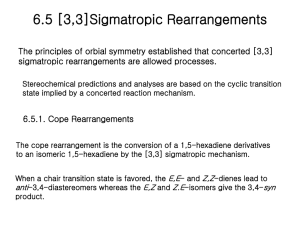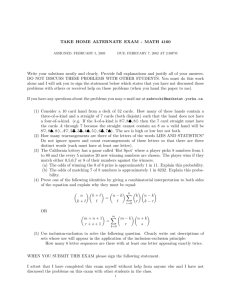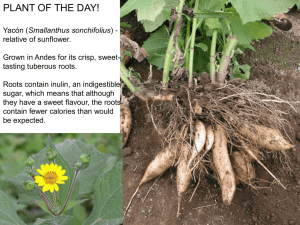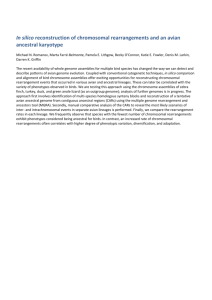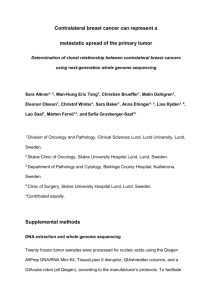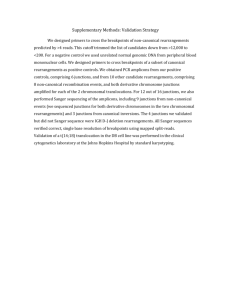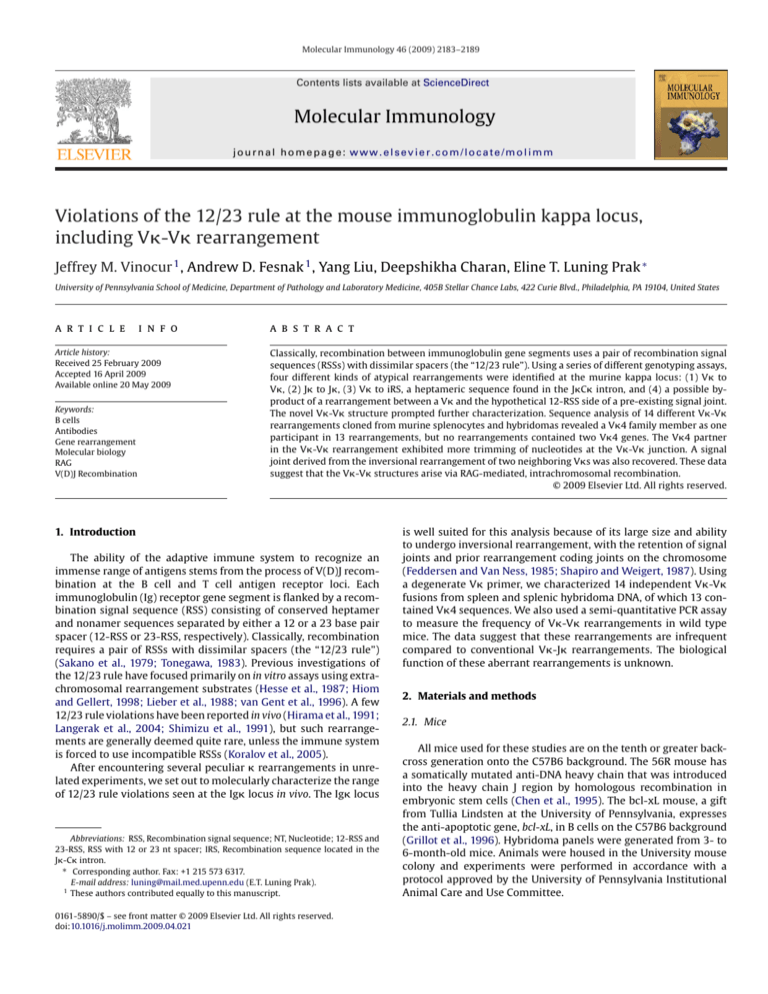
Molecular Immunology 46 (2009) 2183–2189
Contents lists available at ScienceDirect
Molecular Immunology
journal homepage: www.elsevier.com/locate/molimm
Violations of the 12/23 rule at the mouse immunoglobulin kappa locus,
including V-V rearrangement
Jeffrey M. Vinocur 1 , Andrew D. Fesnak 1 , Yang Liu, Deepshikha Charan, Eline T. Luning Prak ∗
University of Pennsylvania School of Medicine, Department of Pathology and Laboratory Medicine, 405B Stellar Chance Labs, 422 Curie Blvd., Philadelphia, PA 19104, United States
a r t i c l e
i n f o
Article history:
Received 25 February 2009
Accepted 16 April 2009
Available online 20 May 2009
Keywords:
B cells
Antibodies
Gene rearrangement
Molecular biology
RAG
V(D)J Recombination
a b s t r a c t
Classically, recombination between immunoglobulin gene segments uses a pair of recombination signal
sequences (RSSs) with dissimilar spacers (the “12/23 rule”). Using a series of different genotyping assays,
four different kinds of atypical rearrangements were identified at the murine kappa locus: (1) V to
V, (2) J to J, (3) V to iRS, a heptameric sequence found in the JC intron, and (4) a possible byproduct of a rearrangement between a V and the hypothetical 12-RSS side of a pre-existing signal joint.
The novel V-V structure prompted further characterization. Sequence analysis of 14 different V-V
rearrangements cloned from murine splenocytes and hybridomas revealed a V4 family member as one
participant in 13 rearrangements, but no rearrangements contained two V4 genes. The V4 partner
in the V-V rearrangement exhibited more trimming of nucleotides at the V-V junction. A signal
joint derived from the inversional rearrangement of two neighboring Vs was also recovered. These data
suggest that the V-V structures arise via RAG-mediated, intrachromosomal recombination.
© 2009 Elsevier Ltd. All rights reserved.
1. Introduction
The ability of the adaptive immune system to recognize an
immense range of antigens stems from the process of V(D)J recombination at the B cell and T cell antigen receptor loci. Each
immunoglobulin (Ig) receptor gene segment is flanked by a recombination signal sequence (RSS) consisting of conserved heptamer
and nonamer sequences separated by either a 12 or a 23 base pair
spacer (12-RSS or 23-RSS, respectively). Classically, recombination
requires a pair of RSSs with dissimilar spacers (the “12/23 rule”)
(Sakano et al., 1979; Tonegawa, 1983). Previous investigations of
the 12/23 rule have focused primarily on in vitro assays using extrachromosomal rearrangement substrates (Hesse et al., 1987; Hiom
and Gellert, 1998; Lieber et al., 1988; van Gent et al., 1996). A few
12/23 rule violations have been reported in vivo (Hirama et al., 1991;
Langerak et al., 2004; Shimizu et al., 1991), but such rearrangements are generally deemed quite rare, unless the immune system
is forced to use incompatible RSSs (Koralov et al., 2005).
After encountering several peculiar rearrangements in unrelated experiments, we set out to molecularly characterize the range
of 12/23 rule violations seen at the Ig locus in vivo. The Ig locus
Abbreviations: RSS, Recombination signal sequence; NT, Nucleotide; 12-RSS and
23-RSS, RSS with 12 or 23 nt spacer; IRS, Recombination sequence located in the
J-C intron.
∗ Corresponding author. Fax: +1 215 573 6317.
E-mail address: luning@mail.med.upenn.edu (E.T. Luning Prak).
1
These authors contributed equally to this manuscript.
0161-5890/$ – see front matter © 2009 Elsevier Ltd. All rights reserved.
doi:10.1016/j.molimm.2009.04.021
is well suited for this analysis because of its large size and ability
to undergo inversional rearrangement, with the retention of signal
joints and prior rearrangement coding joints on the chromosome
(Feddersen and Van Ness, 1985; Shapiro and Weigert, 1987). Using
a degenerate V primer, we characterized 14 independent V-V
fusions from spleen and splenic hybridoma DNA, of which 13 contained V4 sequences. We also used a semi-quantitative PCR assay
to measure the frequency of V-V rearrangements in wild type
mice. The data suggest that these rearrangements are infrequent
compared to conventional V-J rearrangements. The biological
function of these aberrant rearrangements is unknown.
2. Materials and methods
2.1. Mice
All mice used for these studies are on the tenth or greater backcross generation onto the C57B6 background. The 56R mouse has
a somatically mutated anti-DNA heavy chain that was introduced
into the heavy chain J region by homologous recombination in
embryonic stem cells (Chen et al., 1995). The bcl-xL mouse, a gift
from Tullia Lindsten at the University of Pennsylvania, expresses
the anti-apoptotic gene, bcl-xL, in B cells on the C57B6 background
(Grillot et al., 1996). Hybridoma panels were generated from 3- to
6-month-old mice. Animals were housed in the University mouse
colony and experiments were performed in accordance with a
protocol approved by the University of Pennsylvania Institutional
Animal Care and Use Committee.
2184
J.M. Vinocur et al. / Molecular Immunology 46 (2009) 2183–2189
2.2. Hybridomas
2.5. Statistical analysis
Spontaneous hybridomas from 3-month-old B6 and B6.56R.BclxL mice were produced by fusion of the murine myeloma cell line
Sp2/0 (Kohler, 1980) to freshly harvested splenocytes as described
previously (Luning Prak et al., 1994). Hybridomas were cultured
at limiting dilution and expanded into duplicate 6-well plates for
analysis of culture supernatants and nucleic acid extraction, as
described previously (Luning Prak et al., 1994). Hybridomas from
B6.56R mice were produced for a separate study, but characterized
for atypical rearrangements in this study (Sekiguchi et al., 2006).
As described in Section 3, we encountered a predominance of
V4–non-V4 rearrangements, without any V4-V4 rearrangements. To calculate the likelihood these results could be due to
chance, we considered a model wherein different V genes have
independent probabilities of undergoing V-V rearrangement.
This model assumes that the assay, which relies upon the use of
a degenerate V primer, does not result in the biased amplification
of particular V gene families. Based on our previous experience,
we know that the Vs primer can amplify approximately 80% of all V
gene family members, including V4 and non-V4 genes (Luning
Prak et al., 1994). Applying this model, there is some unknown probability p that any given gene we recover is from the V4 family.
Assuming that the 14 V-V sequences shown in Table 1 are derived
from independent clones of B cells (based on sequence differences),
p, the frequency of V4, is estimated to be 13/28. The chance that
both Vs in a given pairing are V4 is (0.464)2 = 0.21, assuming that
V4 and non-V4 genes rearrange independently. The chance of
not seeing V4-V4 in 14 V-V pairings is (1 − 0.21)14 = 0.037. A
Student’s t-test (one-tailed, equal variance) was used to compare
the 3 trim length of V4 to non-V4 partners in the 14 V-V
rearrangements.
2.3. PCR primers and conditions
All PCRs were performed with 100–250 ng of genomic DNA from
spleen or individual spontaneous B6 hybridomas, in 1× PCR Buffer
I (Applied Biosystems, Foster City, CA) with 1.5 U AmpliTaq Gold
(Applied Biosystems) and 250 M dNTPs. The Vs PCR was performed as described above in a 20 L reaction volume, with 40 pmol
of a degenerate primer in V (Schlissel and Baltimore, 1989). Thermal cycling conditions were: primary denaturation at 94 ◦ C for
10 min; 40 cycles of 94 ◦ C for 30 s, 67 ◦ C for 30 s, and 72 ◦ C for
30 s; and final extension at 72 ◦ C for 10 min. Assays to characterize
rearrangements in individual hybridomas to V20 and V21 were
performed as described previously (Li et al., 2001). Assays to detect
signal joints remaining on the chromosome after J to J inversion
were performed as described above, with 20 pmol of each primer:
5 -AATCAGCAGTTCTCTGTCAGAGAAGCC-3
J1for:
J4for: 5 -CACGTTCGGCTCGGGGACAAAGTTGGAA-3
Thermal cycling conditions were: primary denaturation at 94 ◦ C
for 10 min; 40 cycles of 94 ◦ C for 30 s, 60 ◦ C for 30 s, and 72 ◦ C for
30 s; and final extension at 72 ◦ C for 5 min.
PCR assays to detect signal joints remaining on the chromosome
after V to V inversion were performed using primers situated in
genomic DNA sequences flanking individual V RSSs. The primers
used for this analysis are:
V4-86 SJP: 5 -TCCTGCCAGTGTGAAGACAG-3
V1-88 SJP: 5 -TGATGAAGGCTGTCATGCTCA-3
The signal joint amplification was performed in a 50 L volume
using 50 pmol of each primer and the same concentrations of all
of the other mix components as the J-J PCR described above.
Cycling conditions were: primary denaturation at 94 ◦ C for 10 min;
40 cycles of 94 ◦ C for 30 s, 65 ◦ C for 30 s, and 72 ◦ C for 30 s; and final
extension at 72 ◦ C for 10 min.
2.4. Cloning and sequence analysis
PCR products were band purified using a Qiaquick gel extraction kit, per the manufacturer’s instructions (Qiagen, Valencia,
CA) and either sequenced directly or cloned into pCR4 TOPO
per the manufacturer’s instructions (Invitrogen, Carlsbad, CA).
Sequencing was performed on an ABI 3730 using BigDye Taq
FS terminator V 3.1 in the University of Pennsylvania DNA
Sequencing facility (http://www.med.upenn.edu/genetics/corefacs/dna-seq/). Sequences (in both directions) were aligned
and compared to germline V sequences using IgBLAST
(http://ncbi.nih.gov/igblast/). Nomenclature used for V gene
segments follows the system described in reference Brekke and
Garrard, 2004.
3. Results
3.1. Atypical VÄ-VÄ gene rearrangements occur in vivo
During routine hybridoma genotyping, we noted a PCR product
of unexpected size that, on sequence analysis, appeared to be a VV rearrangement. We first confirmed that the unexpected product
could be amplified with Vs (a degenerate V primer, see Section 2)
alone in the reaction mix. We then used Vs PCR to identify additional
examples from spleen DNA of mice. Table 1 illustrates the range of
V-V rearrangements that were recovered.
3.2. VÄ-VÄ rearrangements likely invert and may also delete
To better understand the mechanism of V-V rearrangement,
we examined the germline positions and orientations of the participating gene segments. The gene pairs involved have a variety
Table 1
V usage and DNA source of cloned V-V rearrangements.
B6 spleen
1.
2.a
3.
V23-48
V33-84 or Vk33-85
V12-41
V4-78
V4-80
V8-24
B6.Bcl-xL spleen
4.
5.
6.b
7.
8.
9.
10.
11.
12.
V23-43 or Vk23-45
V12-44 or Vk12-46
V1-117
V12-46
V1-110
V1-117
V33-84 or V33-85
V1-88
V1-110
V4-53
V4-54
V4-60 or V4-68
V4-70
V4-77
V4-77
V4-79
V4-86
V4-86
B6.56R.Bcl-xL hybridoma
V1-117
13.b
V4-60 or V4-68
B6 hybridoma
14.a
V4-80
V33-84 or V33-85
Four different mice provided splenocytes. Spleen refers to spleen DNA. Hybridoma
refers to spontaneous hybridomas produced from the spleen (see Section 2). The
V gene assignments are based on DNA sequence analysis (see Section 2). Two
pairs of V-V rearrangements that use the same V gene segments (but were
independently recovered from different mice) are indicated with footnotes (a or
b) to the right of the corresponding sequence numbers. The junction of each V-V
rearrangement is shown in Fig. 3a.
J.M. Vinocur et al. / Molecular Immunology 46 (2009) 2183–2189
2185
Fig. 1. Chromosomal locations of V gene segments that were found in V-V rearrangements. The V gene segments that have been identified in 14 independent V-V
rearrangements are shown, based on the positions of their V gene segments in the germline locus. The color of the triangles is used to identify partners of a V-V fusion
(partners share the same color and are listed in Table 1). The direction of the triangles is used to denote the V gene segment orientation in the germline locus, as described
previously (Brekke and Garrard, 2004; Thiebe et al., 1999).
of relative configurations in the germline (Fig. 1). Assuming that
these rearrangements arise by recombining V segments that
are on the same chromosome and are in the germline configuration, these data suggest that V-V rearrangements can occur
by inversion or deletion (Fig. 2b; the conventional V-J rearrangement is shown in Fig. 2a for general orientation). Consistent
with this possibility, we recovered a reciprocal product using
primers that faced towards the recombination signal sequences
of two neighboring Vs, V1-88 and V4-86 (Fig. 2c, the anno-
tated sequence is given in Fig. S1 of the electronic supplement).
In the germline configuration, these primers do not efficiently
amplify genomic DNA because they are facing in the same direction. V1-88 and V4-86 genes are adjacent in the germline
Ig locus, thus a single rearrangement can produce their V-V
fusion and the corresponding signal joint. However, primary rearrangement is not the only possible pathway for Vs that are not
immediately adjacent to one another. Some of the V-V rearrangements could represent secondary rearrangements, on alleles
Fig. 2. (a) Conventional V-J rearrangement. A deletional rearrangement of V to J is depicted. The V gene segment is flanked by a 3 recombination signal sequence
with a 12 base pair spacer (12-RSS, white triangle). The J gene segment is flanked by a 5 recombination signal sequence with a 23 base pair spacer (23-RSS, black triangle).
The recombination results in the generation of a coding joint (V-J, on the left) and a signal joint (an episome containing the two fused RSSs, on the right). (b) VV rearrangements may occur by inversion or deletion. Shown are two schematic pairs of V gene segments undergoing either inversional rearrangement (VA, VB) or
deletional rearrangement (VC, VD). Whether V-V rearrangement results in inversion or deletion is dictated by the orientation of the V gene segments. As shown in Fig. 1,
both deletional and inversional rearrangements are possible, based on the orientations of the V-V pairs in the germline locus. Boxes denote exons, lines introns and white
triangles represent 12-RSS. (c) Inversional V-V Rearrangement and Signal Joint. Shown is a proposed inversional rearrangement that involves two neighboring V gene
segments, V1-88 and V4-86. The signal joint, consisting of two facing 12-RSSs, is retained on the chromosome. The V1-88/V4-86 rearrangement and the corresponding
signal joint were amplified and cloned from independent PCR amplifications of spleen DNA from two different mice (see Section 2). The nucleotide sequence of the signal
joint is excerpted in Fig. 3b (#1) and the full sequence is provided in Fig. S1 of the electronic supplement.
2186
J.M. Vinocur et al. / Molecular Immunology 46 (2009) 2183–2189
already modified by deletions and/or inversions from preceding
rearrangements.
3.3. VÄ-VÄ rearrangement commonly involves the VÄ4 gene
family
Almost every V-V rearrangement we recovered (13/14) contains exactly one V4 gene (Table 1). The large size of the V4 family
and the possibility that the degenerate Vs primer may not recognize
all V genes equally well could contribute to an increased likelihood
of recovering V4 rearrangements. However, such causes of bias
would, as described in Methods, predict that V4-V4 rearrangements should also be present. Using the assumptions described in
the Section 2, we calculate a probability of 4% of encountering no
V4-V4 rearrangements due to chance.
3.4. VÄ-VÄ rearrangements demonstrate junctional modifications
suggesting RAG involvement
V-V rearrangements resemble canonical V-J rearrangements in that they appear to use the 3 RSS. Examination of the 14
V-V junctions reveals frequent “nibbling” (nucleotide deletion at
junction ends) of up to 8 nt per end and three instances of probable
“P addition” (insertion of palindromic nucleotides complementary
to a non-nibbled end, Fig. 3a). These modifications resemble those
seen at normal VJ coding joints (Martin et al., 1992; Meier and
Lewis, 1993; Victor et al., 1994). V4 gene segments appear to harbor fewer 3 nucleotides than their non-V4 partners; on average,
3.3 residues were missing from the 3 end of the V4 gene compared
to 2.1 residues from the non-V4 gene (p=0.07, 1-tailed Student’s
t-test).
3.5. VÄ-VÄ rearrangements are infrequent in splenocytes
To determine the frequency of V-V rearrangements, a semiquantitative PCR assay was performed on different quantities of
wild type spleen DNA (Fig. S2). V-V amplification was present
with ∼100 ng of input DNA from a C57B6 mouse. Assuming that
half of the DNA mass in the spleen is due to B cells, that each cell
contains approximately 6.7 pg genomic DNA, that the V-V PCR
efficiently recovers all V-V rearrangements and that each cell
harbors at most one V-V rearrangement, this corresponds to a
V-V rearrangement frequency of approximately one in 7500 B
cells.
3.6. A variety of atypical rearrangements can occur in vivo
In addition to V-V rearrangements, we have recovered evidence of several other atypical rearrangements. In a splenic
hybridoma from an anti-DNA heavy chain knock-in mouse (B6.56R
(Chen et al., 1995; Li et al., 2001; Sekiguchi et al., 2006)), we recovered a J1–J5 rearrangement (Fig. 4a) as well as a hybrid joint
involving a V20 and the J4 RSS (Fig. 4b). The two junctions were
in close proximity and oriented to permit inadvertant amplification
on a routine genotyping PCR. In a hybridoma from a B6.56R.bclxL mouse, we encountered a rearrangement involving a V12 and
the JC intron upstream of the intronic RS (Fig. 4c). The existence of V to JC intron rearrangements has been demonstrated
previously in the B cell line MPC-11 (Seidman and Leder, 1980)
and further substantiated by the analysis Abelson murine leukemia
virus transformant subclones (Feddersen et al., 1990). Atypical rearrangements involving the JC intron RSS also include J1-iRS
fused signal join in the plasmacytoma PC 8701 (Kelley et al., 1985)
as well as a reciprocal product (Shimizu et al., 1991).
All three of these atypical rearrangements exhibit junctional
modifications on one or both ends (Fig. 3b). Each J has a 23-RSS,
so the J-J rearrangement violates the 12/23 rule. The V-JC
intron rearrangement “bends” the 12/23 rule, in that the intronic
RS is degenerate, but does classically recombine with the 23-RSS of
the downstream RS element. Finally, the V-J RSS rearrangement,
involving secondary rearrangement into a signal joint, appears to
require a 12/23 rule violation; however, if we postulate a J–iRS signal joint (Langerak et al., 2004) as an intermediate, the V would
then recombine with the iRS heptamer, also only “bending” the
12/23 rule.
4. Discussion
Diversity is both important and dangerous for the immune system. As such, mechanisms that influence diversity, such as the
12/23 rule, are complex in their biological effects. On one hand,
efficient recombination between dissimilar RSS spacers promotes
diversification. For example, at the heavy chain locus, the 12/23 rule
enforces the incorporation of DH segments, increasing CDR3 length
and repertoire complexity (Ippolito et al., 2003; Sakano et al., 1981).
On the other hand, given the fact that all gene segments of a given
type (V, D, or J) at each antigen receptor locus use the same size
spacer, the 12/23 rule discourages recombinations that are unlikely
to yield a meaningful antigen receptor.
In this investigation of V(D)J recombination at the mouse Ig
locus, we describe a variety of rearrangements that apparently
violate the 12/23 rule, including V-V rearrangement, J-J rearrangement, and others. Most of the rearrangements analyzed in
this study harbor junctional modifications (nucleotide deletion and
occasionally P addition). All 14 V-V sequences that were recovered were unique (based on the V-V junction). However, there
does appear to be a preference for particular V gene segment combinations (Fig. 1). Two V-V rearrangements were each observed
twice: V80 to V33-84/85 and V60 to V1-117.
In addition to the seemingly non-random usage of particular
V-V pairs, there is an intriguing tendency for V-V rearrangements to involve gene segments from the V4 family. 13 out of the
14 V-V rearrangements use gene segments from the V4 family. The high frequency of V4 usage is not unique to a particular
mouse, as these rearrangements were independently cloned from
two different mouse spleens and recovered from hybridomas from
two other mice. While V4 is not absolutely required, its usage
is favored amongst V-V rearrangements. V4 is the largest V
gene family in the mouse, consisting of 27 members and comprising 28% of functional murine V gene segments (Brekke and
Garrard, 2004). If rearrangements to different V gene segments
are uniformly distributed, then V4 should be present in a sizable
fraction of V-V rearrrangements. However, only one V4 is found
in each of the V4-containing rearrangements. Attempts to amplify
V4-V4 rearrangements with a V4-specific primer failed (data
not shown). Failure to amplify V4-V4 rearrangements is likely
to reflect the rarity of V4-V4 rearrangement, but could also be
due to difficulty in cloning and/or sequencing rearrangements with
highly homologous Vs.
We wondered if there could be a structural feature of V4 family members that would make them more likely to participate in
aberrant rearrangement. We noticed that the 3 ends of the V4
partner in the V-V rearrangement were shorter (being recessed
an average of 3.3 nt compared to the germline sequence), than
the non-V4 partner (which was recessed 2.1 nt, compared to the
germline sequence). Most murine kappa light chains have a highly
conserved proline residue at position 95 (Pro95 ) that is important
for CDR3 folding (Chothia and Lesk, 1987; Kabat et al., 1983). Most
of the V4 genes in our V-V collection have four nucleotides
between Pro95 and the RSS heptamer, whereas most V genes,
including the non-V4 genes in our V-V collection, only have
two bases (Milstein et al., 1992). This asymmetric trimming was
first noted in conventional V4 to J2 or J5 rearrangements cloned
J.M. Vinocur et al. / Molecular Immunology 46 (2009) 2183–2189
2187
Fig. 3. (a) Nucleotide Sequences of V-V junctions. Each V gene contributes nucleotides from its 3 end to the V-V junction. Here, the corresponding germline sequences
appear in bold font above each junction to permit analysis of junctional modification. A bar between the germline and experimental sequences indicate regions of identity.
Nucleotides that cannot be attributed to a particular germline sequence are shown centered in the junction. Displayed sequences are from the CDR3 of each gene, aligned
against each other, and the V families contributing to each junction are shown. The sequence numbering corresponds to the numbering in Table 1, which provides the
mouse/tissue/hybridoma origin of each sequence. For consistency, the top strands of the non-V4 genes are shown on the left and the bottom strands of the V4 genes
(when present) are shown on the right. An example of one of these rearrangements (involving V1-88 and V4-86) and its corresponding signal joint is shown in Fig. 2c. (b)
Sequences of other atypical rearrangements. Sequence data from the atypical junctions shown in Fig. 4a–c appear with the corresponding portions of the germline Ig locus.
The notation is as described for Fig. 3a. In the hybrid joint involving the J4 RSS, “23 bp” indicates the spacer between the heptamer (shown, with junctional modification)
and the nonamer (shown, preserved). Similarly, in the V-V signal joint, the 12-RSS spacer is denoted “12 bp”. The DNA sources of the sequences are: (1) B6 spleen; (2)
B6.bcl-xL spleen; (3) B6.bcl-xL spleen; (4) B6.56R.bcl-xL hybridoma; (5) B6.56R hybridoma; (6) B6.56R hybridoma.
from BALB/c spleen DNA (Milstein et al., 1992). Thus, on average,
V4 genes exhibit more “trimming” (or RAG is permitted to cut
more sloppily), but there is usually more DNA “to spare” between
Pro95 and the heptamer (Milstein et al., 1992). Our data, as well as
the out of frame rearrangements recovered in the earlier analysis
of V4-J2/5 rearrangements, suggest that this 3 length asymmetry is intrinsic to the rearrangement mechanism, rather than
being due to selection for V4 rearrangements of a particular CDR3
length.
We also noticed that V4 genes tend to have nucleotide
sequences that are rich in Gs and Ts on the non-coding strand
(the V4 sequences in Fig. 3a are aligned to illustrate this) and
include stretches of 2–4 Gs and GTGs. It is possible, as suggested
by Gellert, that these sequences result in an unusual DNA struc-
2188
J.M. Vinocur et al. / Molecular Immunology 46 (2009) 2183–2189
Fig. 4. Schematics of Different Atypical Kappa Rearrangements. (a) Probable inversional rearrangement between J5 and J1. The signal joint contains 23-RSS sequences
derived from J1 and J5 (because they are flanked by intronic sequences upstream of J1 and J5). Only the J4 sequence is shown to the right of the signal joint because only
the J4 segment was recovered in the PCR due to the use of primers upstream of J1 and within J4 (arrows). Two distinct rearrangements of this type were recovered; the
sequences are excerpted in Fig. 3b (#2 and #3) and provided in detail in Fig. S3. (b) Complex Aberrant Rearrangements on one chromosome of a hybridoma. Rearrangements
involving V20, probably J4 (RSS-23), J2 and J5 were recovered in a single PCR amplification using primers in J5 and V20 (arrows) in a splenic hybridoma derived
from a 56R anti-DNA heavy chain knock in mouse (Sekiguchi et al., 2006). Two possible rearrangement scenarios are illustrated, both of which begin with an inversional
rearrangement between J1 and J4. After the presumed inversion, V20 is postulated to invade the proposed J1/J4 signal joint and J2 is postulated to rearrange to J5,
deleting the intervening Js. The open triangle with wavy edging indicates an incomplete 23-RSS with bases missing from the heptamer. Based on the flanking sequence,
this heptamer most likely derives from the J4 gene segment. Both junctions from these complex rearrangements were recovered; the sequences are excerpted in Fig. 3b
(#5 and #6) and provided in detail in Fig. S4. (c) Probable Inversional Rearrangement of V12 to the JCintron Heptamer. A PCR product containing a conventional V4-J2
rearrangement, the J4 and J5 gene segments, part of the JC-intron and an inverted V12 gene segment was obtained, demonstrating loss of the JCintron heptamer (Fig. 3b).
The simplest explanation is an inversional rearrangement of V12 to the cryptic heptamer in the JCintron on an allele that has already undergone conventional V4-J2
rearrangement. The dashed triangle represents the cryptic heptamer of the intronic RSS. The sequence of the atypical rearrangement is excerpted in Fig. 3b (#4) and provided
in detail in Fig. S5.
ture that may be recognized by the recombination machinery
(Gellert, 1992). Because V-V rearrangements involve the apposition of two RSS-12 sequences, having two altered DNA structures
in close apposition (such as two V4 family members) could be
prohibitive. It is interesting that coding sequences can influence
the efficiency of recombination over 250-fold, although this has
not been directly tested for two RSS-12 containing recombination
substrates (Gerstein and Lieber, 1993).
Our agnostic approach to recovering atypical rearrangement products provides insights into the stringency of V(D)J
recombination in a physiologic in vivo system. Presumably, these
rearrangements are mediated by the RAG enzymes, given the pattern of cleavage: the recombination signal sequence at the 3 end
of the Vs is missing from all of the V-V rearrangements that
were recovered. The recovery of a reciprocal product is consistent
with intrachromosomal RAG-mediated inversional recombination
to generate at least one of the V-V rearrangements. The signal
joint in this reciprocal product was perfectly intact, which is different from a mechanism proposed for re-entry of damaged signal
joints into the genome (Neiditch et al., 2002). In the latter case, a
damaged signal joint is postulated to re-invade an RSS or cryptic
RSS.
RAG-mediated recombination beyond the traditional boundaries of V(D)J recombination is inherently dangerous (Hiom et al.,
1998) and many previously characterized translocation breakpoints
involve the immunoglobulin or TCR loci. It is possible that the fre-
quency of V-V rearrangement in mature splenocytes (which have
survived negative selection) underestimates the frequency of these
aberrant rearrangements during lymphocyte maturation. In addition to the potential dangers of generating V-V rearrangements,
the rearrangement product, if transcribed, has the potential to form
a hairpin, due to oppositely facing Vs. V hairpin RNAs, if they
exist, could silence .
Acknowledgments
We thank members of the Luning Prak laboratory, Martin
Weigert and Craig Bassing for helpful discussions. We thank the
University of Pennsylvania DNA Sequencing facility for their expertise and technical contributions to this study. E.L.P. is supported by
grants from the NIH, Alliance for Lupus Research and Southern New
Jersey Lupus Society. J.M.V. was supported by a T32 training grant
from the NIDDK and D.C. was supported by the Goldie Simon Award
from the Southeastern Pennsylvania Lupus Society (re-named
the Philadelphia Tri-State Chapter of the Lupus Foundation of
America).
Appendix A. Supplementary data
Supplementary data associated with this article can be found, in
the online version, at doi:10.1016/j.molimm.2009.04.021.
J.M. Vinocur et al. / Molecular Immunology 46 (2009) 2183–2189
References
Brekke, K.M., Garrard, W.T., 2004. Assembly and analysis of the mouse immunoglobulin kappa gene sequence. Immunogenetics 56, 490–505.
Chen, C., Nagy, Z., Prak, E.L., Weigert, M., 1995. Immunoglobulin heavy
chain gene replacement: a mechanism of receptor editing. Immunity 3,
747–755.
Chothia, C., Lesk, A.M., 1987. Canonical structures for the hypervariable regions of
immunoglobulins. J. Mol. Biol. 196, 901–917.
Feddersen, R.M., Martin, D.J., Van Ness, B.G., 1990. Novel recombinations of the IG
kappa-locus that result in allelic exclusion. J. Immunol. 145, 745–750.
Feddersen, R.M., Van Ness, B.G., 1985. Double recombination of a single
immunoglobulin kappa-chain allele: implications for the mechanism of rearrangement. Proc. Natl. Acad. Sci. U. S. A. 82, 4793–4797.
Gellert, M., 1992. Molecular analysis of V(D)J recombination. Annu. Rev. Genet. 26,
425–446.
Gerstein, R.M., Lieber, M.R., 1993. Coding end sequence can markedly affect the
initiation of V(D)J recombination. Genes Dev. 7, 1459–1469.
Grillot, D.A., Merino, R., Pena, J.C., Fanslow, W.C., Finkelman, F.D., Thompson, C.B.,
Nunez, G., 1996. bcl-x exhibits regulated expression during B cell development
and activation and modulates lymphocyte survival in transgenic mice. J. Exp.
Med. 183, 381–391.
Hesse, J.E., Lieber, M.R., Gellert, M., Mizuuchi, K., 1987. Extrachromosomal DNA substrates in pre-B cells undergo inversion or deletion at immunoglobulin V-(D)-J
joining signals. Cell 49, 775–783.
Hiom, K., Gellert, M., 1998. Assembly of a 12/23 paired signal complex: a critical
control point in V(D)J recombination. Mol. Cell 1, 1011–1019.
Hiom, K., Melek, M., Gellert, M., 1998. DNA transposition by the RAG1 and
RAG2 proteins: a possible source of oncogenic translocations. Cell 94, 463–
470.
Hirama, T., Takeshita, S., Yoshida, Y., Yamagishi, H., 1991. Structure of extrachromosomal circular DNAs generated by immunoglobulin light chain gene
rearrangements. Immunol. Lett. 27, 19–23.
Ippolito, G.C., Pelkonen, J., Nitschke, L., Rajewsky, K., Schroeder Jr., H.W., 2003. Antibody repertoire in a mouse with a simplified D(H) locus: the D-limited mouse.
Ann. N. Y. Acad. Sci. 987, 262–265.
Kabat, E.A., Wu, T.T., Bilofsky, H., Reid-Milner, M., Perry, H., 1983. Sequences of Proteins of Immunological Interest, 3rd Edition. Public Heath Service, Washington,
D.C.
Kelley, D.E., Wiedemann, L.M., Pittet, A.C., Strauss, S., Nelson, K.J., Davis,
J., Van Ness, B., Perry, R.P., 1985. Nonproductive kappa immunoglobulin
genes: recombinational abnormalities and other lesions affecting transcription, RNA processing, turnover, and translation. Mol. Cell Biol. 5, 1660–
1675.
Kohler, G., 1980. Immunoglobulin chain loss in hybridoma lines. Proc. Natl. Acad. Sci.
U. S. A. 77, 2197–2199.
Koralov, S.B., Novobrantseva, T.I., Hochedlinger, K., Jaenisch, R., Rajewsky, K., 2005.
Direct in vivo VH to JH rearrangement violating the 12/23 rule. J. Exp. Med. 201,
341–348.
2189
Langerak, A.W., Nadel, B., De Torbal, A., Wolvers-Tettero, I.L., van Gastel-Mol, E.J.,
Verhaaf, B., Jager, U., van Dongen, J.J., 2004. Unraveling the consecutive recombination events in the human IGK locus. J. Immunol. 173, 3878–3888.
Li, H., Jiang, Y., Prak, E.L., Radic, M., Weigert, M., 2001. Editors and editing of anti-DNA
receptors. Immunity 15, 947–957.
Lieber, M.R., Hesse, J.E., Mizuuchi, K., Gellert, M., 1988. Studies of V(D)J recombination
with extrachromosomal substrates. Curr. Top. Microbiol. Immunol. 137, 94–99.
Martin, T., Blaison, G., Levallois, H., Pasquali, J.L., 1992. Molecular analysis of the
V kappa III-J kappa junctional diversity of polyclonal rheumatoid factors during rheumatoid arthritis frequently reveals N addition. Eur. J. Immunol. 22,
1773–1779.
Meier, J.T., Lewis, S.M., 1993. P nucleotides in V(D)J recombination: a fine-structure
analysis. Mol. Cell Biol. 13, 1078–1092.
Milstein, C., Even, J., Jarvis, J.M., Gonzalez-Fernandez, A., Gherardi, E., 1992. Nonrandom features of the repertoire expressed by the members of one V kappa
gene family and of the V-J recombination. Eur. J. Immunol. 22, 1627–1634.
Neiditch, M.B., Lee, G.S., Huye, L.E., Brandt, V.L., Roth, D.B., 2002. The V(D)J recombinase efficiently cleaves and transposes signal joints. Mol. Cell 9, 871–878.
Luning Prak, E., Trounstine, M., Huszar, D., Weigert, M., 1994. Light chain editing in
kappa-deficient animals: a potential mechanism of B cell tolerance. J. Exp. Med.
180, 1805–1815.
Sakano, H., Huppi, K., Heinrich, G., Tonegawa, S., 1979. Sequences at the somatic
recombination sites of immunoglobulin light-chain genes. Nature 280, 288–294.
Sakano, H., Kurosawa, Y., Weigert, M., Tonegawa, S., 1981. Identification and
nucleotide sequence of a diversity DNA segment (D) of immunoglobulin heavychain genes. Nature 290, 562–565.
Schlissel, M.S., Baltimore, D., 1989. Activation of immunoglobulin kappa gene rearrangement correlates with induction of germline kappa gene transcription. Cell
58, 1001–1007.
Seidman, J.G., Leder, P., 1980. A mutant immunoglobulin light chain is formed by
aberrant DNA- and RNA-splicing events. Nature 286, 779–783.
Sekiguchi, D.R., Yunk, L., Gary, D., Charan, D., Srivastava, B., Allman, D., Weigert, M.G.,
Prak, E.T., 2006. Development and selection of edited B cells in B6.56R mice. J.
Immunol. 176, 6879–6887.
Shapiro, M.A., Weigert, M., 1987. How immunoglobulin V kappa genes rearrange. J.
Immunol. 139, 3834–3839.
Shimizu, T., Iwasato, T., Yamagishi, H., 1991. Deletions of immunoglobulin C kappa
region characterized by the circular excision products in mouse splenocytes. J.
Exp. Med. 173, 1065–1072.
Thiebe, R., Schable, K.F., Bensch, A., Brensing-Kuppers, J., Heim, V., Kirschbaum, T.,
Mitlohner, H., Ohnrich, M., Pourrajabi, S., Roschenthaler, F., Schwendinger, J.,
Wichelhaus, D., Zocher, I., Zachau, H.G., 1999. The variable genes and gene families of the mouse immunoglobulin kappa locus. Eur. J. Immunol. 29, 2072–2081.
Tonegawa, S., 1983. Somatic generation of antibody diversity. Nature 302, 575–581.
van Gent, D.C., Ramsden, D.A., Gellert, M., 1996. The RAG1 and RAG2 proteins establish the 12/23 rule in V(D)J recombination. Cell 85, 107–113.
Victor, K.D., Vu, K., Feeney, A.J., 1994. Limited junctional diversity in kappa light
chains. Junctional sequences from CD43+B220+ early B cell progenitors resemble
those from peripheral B cells. J. Immunol. 152, 3467–3475.


